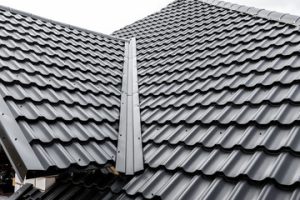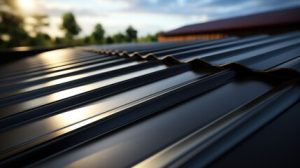Jenks Metal Roofing is a great choice for anyone from builders to homeowners. It is important for individuals, whether they are a contractor, distributor or architect, to understand the pros and cons of each type of metal.

Inspect for cracks, chips and other damage. Also check that all screws are tight and that flashing around vents, chimneys and skylights is sealed.
Weather conditions can be brutal on traditional shingles, but metal roofing is extremely durable and provides excellent protection from harsh weather elements. Most metal roofs last 40-70 years, a long lifespan when compared to traditional asphalt shingles which typically need replacement every 15-20 years. This durability also helps to reduce energy costs and maintain building integrity over time.
In areas prone to extreme weather and high winds, metal roofing is especially valuable. Heavy wind can damage shingles and cause leaks, while metal roofs undergo rigorous testing to ensure they are capable of withstanding severe weather events. With a class 4 impact rating, metal roofs are designed to protect your property from damage caused by hail and other destructive elements.
Whether you live in a tropical storm zone, tornado-prone region or the arid West, a metal roof can provide peace of mind and energy savings. In addition to their durability, metal roofs reflect solar radiant heat and help keep a home or commercial space cooler, significantly reducing cooling costs. A metal roof will also last longer than a traditional shingle roof, so you won’t need to worry about costly repairs or replacements.
With a wide variety of color and finish options available, metal roofs can be customized to fit any aesthetic and complement any architectural style. Stainless steel in particular has been shown to resist corrosion and degradation for 60+ years, making it the optimal choice for outdoor applications.
Metal roofs can be constructed with corrugated or curved sheets and can be installed with various types of joints. Seams can be welded, soldered or fused, and can be sealed using caulking or polymer sealant. In the past, most metal roofs were site-formed, with various folded pieces of sheet metal joining together to form a weatherproof covering. These roofs often required seams to be sealed with lead, tin or copper solder.
Today, most metal roofs are made from galvanized steel, aluminum or copper. While each has its own pros and cons, all of these roof materials are extremely durable and weather resistant. In fact, steel is one of the strongest roofing materials and can withstand strong winds and heavy hail. A galvanized coating prevents rust and makes the roof even more sturdy. Copper roofs are also highly durable, lasting over 100 years and developing a beautiful patina during the process. They are usually more expensive than other metals, however.
Energy Efficient
Metal roofs reflect solar radiant heat, which can reduce cooling costs by up to 25%. This decrease in energy use helps to lessen your building’s carbon footprint, while also saving you money on utility bills. With gas prices at an all time high, saving on energy costs is something that everyone could benefit from.
One of the key things that makes metal roofing so sustainable is that it is made from recycled materials. Many roofs that are made from shingles are discarded after their lifetime, and they can end up in landfills where they take up space and add to pollution. By choosing a metal roof, you can help to reduce the 12 billion square feet of shingle waste that clogs up landfills every year.
Another way that a metal roof is sustainable is because it is lighter than composite materials, and much lighter than shingle or tile roofs. The lighter weight of a roof can help to relieve stress on the structure of your home or business, and it can also aid in reducing the pressure put on gutters and other rooftop equipment.
The color of a metal roof also has an impact on its energy efficiency. Darker colors tend to absorb more heat, whereas light-colored roofs will reflect more of the sun’s rays. This can help to lower your energy bill and make your building more comfortable.
A metal roof can be even more energy efficient with some simple upgrades. Adding a reflective underlayment can increase the metal’s thermal emittance, which can help it to release absorbed heat more quickly and prevent excess heat from building up in your attic.
The energy efficiency of a metal roof can be further enhanced with the addition of insulating panels. These panels can be installed between the metal roof and the underlayment to provide an extra layer of protection against the elements. This can be especially important in a hot, humid climate like ours, where moisture is a concern. When you combine a well-designed insulation system with a metal roof, you can expect to enjoy impressive energy savings.
Versatile
Metal roofing provides a unique combination of durability, energy efficiency, and aesthetic versatility. It is available in a range of styles to compliment various architectural visions, from modern to traditional. In addition, this roofing material is resistant to severe weather conditions and offers a wide variety of color options to suit any aesthetic preference.
When people envision a metal roof, they often picture the shiny silver panels that are found on barns and warehouses. However, this type of roofing is more versatile than ever before. Metal roofs come in a wide variety of colors, panel thicknesses, profiles, textures, and finishes to fit any architectural vision. They are also durable and require very little maintenance to keep them looking pristine.
Many people choose to paint their metal roofs to match the color scheme of their home or office building. The choice of color is also important because it can impact the energy efficiency of the roof by influencing how much heat is absorbed or reflected. Additionally, the color of the roof can impact how well it blends with the surrounding environment.
Stainless steel is a popular choice for metal roofs because it can withstand harsh weather and temperature climates. It is also a sustainable choice because it can be recycled at the end of its long service life. In fact, stainless steel contains more recycled content than any other metal product.
While many people worry that metal roofs are noisy during rain or storms, this is a myth. Modern installation techniques and insulation effectively dampen noise from wind, rain, and hail.
When paired with the right accessories and trim, metal roofs can complement any architectural style. For instance, ridge caps can add functionality and style to the roof, while gutter systems help protect against water damage. Other decorative elements like finials, weathervanes, and cupolas can add a personal touch to the roof and enhance the overall look of the structure.
Affordable
The initial cost of a metal roof may be higher than shingles, but when you consider the durability, energy efficiency, and low maintenance costs, it is often a wise investment. A well-installed metal roof will last far longer than a traditional asphalt shingle roof, meaning it won’t need replacement for decades. In addition, a metal roof is much more fire resistant than other roofing materials and can withstand severe weather conditions such as high winds and hail.
The price of a metal roof can vary depending on the type of material, panel style, and pitch of your roof. For example, copper roofs are a premium option with an impressive lifespan, but they also have a higher upfront cost than other metals such as galvanized steel or zinc. Corrugated metal roofing, on the other hand, is a budget-friendly workhorse that offers the same strength and longevity as more expensive options. It can also be painted or covered with a variety of finishes to suit your aesthetic preferences.
Another factor that affects metal roofing costs is the size and complexity of your roof. Larger roofs require more materials and labor, which increases the overall cost. Additionally, steeper roofs are more challenging to cover and may require specialized installation techniques. Finally, if you want to add features like skylights or vents, they will increase both the material and installation costs.
Professional installation is essential for a long-lasting and durable roof, and while this expense will increase your total cost, it will ensure that your roof is installed correctly. A quality contractor will also provide warranties that offer peace of mind and financial protection in the event that your roof suffers damage or a manufacturing defect.
The cost of a metal roof will depend on the size and complexity of your roof, but you can expect to spend significantly less on maintenance than you would with a shingle roof. In addition to the durability and low repair costs, metal roofs are more energy efficient than shingle roofs, which means you’ll save money on your energy bill.
